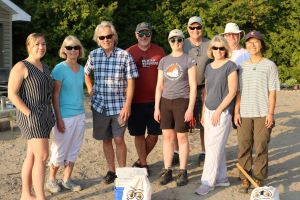 Over the past few years, the Severn Sound region has seen an increase in the number of reported cyanobacteria, also known as blue-green algae blooms, on inland lakes. In particular, there was a reported and documented blue-green algae bloom on Farlain Lake in 2022 which lasted from late July until the end of September. Fortunately we did not experience a bloom this year!
Over the past few years, the Severn Sound region has seen an increase in the number of reported cyanobacteria, also known as blue-green algae blooms, on inland lakes. In particular, there was a reported and documented blue-green algae bloom on Farlain Lake in 2022 which lasted from late July until the end of September. Fortunately we did not experience a bloom this year!
The Severn Sound Environmental Association (SSEA), fully funded by the Township of Tiny, and working with the Farlain Lake Community Association, undertook an Algae Causation Study this past summer, aiming to determine contributing factors that led to last year’s bloom. This study aimed to investigate the cause of the 2022 cyanobacteria bloom in Farlain Lake. The study used field meters to provide an estimate of the amount of algae and early warning indicators of potential blooms, along with an analysis of factors known to lead to the growth of algae and cyanobacteria. The full detailed report is available on the web site here at Our Lake/Blue Green Algae on Farlain Lake. https://farlainlake.ca/our-lake/our-lake-blue-green-algae-in-farlain-lake
Key patterns were observed in both 2023 and 2022 that could potentially explain bloom conditions on Farlain Lake. Based on the citizen science data collected in 2023 and our analysis of SSEA water quality data from 2022 and past, we concluded that the cause of the 2022 bloom was most likely a combination of factors:
1. Climate factors included significant rain events greater than 25 mm (and likely associated nutrient runoff), along with higher surface water and air temperatures. These created ideal conditions for blue-green algal growth. Periods of heavy rainfall and higher surface water and air temperatures were noted before the bloom event in 2022 and potential bloom events in 2023. It is also possible that high water levels on the lake over the past five years have contributed nutrients that have fueled blooms, although this impact is hard to detect with the data available.
2. Another potential factor in the 2022 bloom was the length of the growing season. Ice cover data showed that 2021 and 2022 had more ice-free days than in previous years, which may have been a factor in promoting bloom development in Farlain Lake.
3. Lastly, there may have been increased exposure of lake sediments to sufficiently high light levels, which can favour the growth of one of the species involved in the 2022 bloom (Gloeotrichia) since it begins its lifecycle on the lake bottom.
These conclusions align with scientific research showing that climate factors and light levels can create favourable conditions for cyanobacterial blooms. However, it is crucial to recognize the role of nutrients from shoreline inputs in amplifying these factors. Heavy rainfall can transport nutrients, such as phosphorus and nitrogen, from the shoreline into the lake. The combination of climate conditions and nutrient inputs from human activities increases the risk of harmful algal blooms. This relationship highlights the impacts of shoreline activities on overall water quality and blue-green algal growth on Farlain Lake. Recognizing the importance of human influences on the lake’s ecology emphasizes the critical role of implementing effective management strategies. These can include maintaining a shoreline buffer made up of native plants, avoiding fertilizer use, minimizing hardened surfaces, and ensuring optimal septic system function.
We thank the Township of Tiny for funding this work and the volunteers (pictured above) who participated in the algae monitoring program last summer, along with those who have provided ice observations over the years through SSEA’s Ice Spotters program. Your contributions were crucial to our understanding of the lake!

